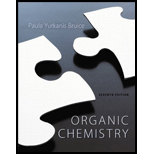
(a)
Interpretation:
The structure of products of given reaction should be drawn.
Concept Introduction:
Terminal
The acetylide carbanion is a good nucleophile and can undergo nucleophilic substitution reactions (usually SN2) with 1o or 2o
3o alkyl halides are more likely to undergo elimination.
One or both of the terminal H atoms in ethylene
The
(b)
Interpretation:
Two sets of reactants that could be used to synthesize a given compound should be given.
Concept Introduction:
Terminal alkynes are unusual for simple hydrocarbons in that they can be deprotonated using an appropriate base (typically
The acetylide carbanion is a good nucleophile and can undergo nucleophilic substitution reactions (usually SN2) with 1o or 2o alkyl halides (
3o alkyl halides are more likely to undergo elimination.
One or both of the terminal H atoms in ethylene
The
(c)
Interpretation:
Two sets of reactants that could be used to synthesize a given compound should be given.
Concept Introduction:
Terminal alkynes are unusual for simple hydrocarbons in that they can be deprotonated using an appropriate base (typically
The acetylide carbanion is a good nucleophile and can undergo nucleophilic substitution reactions (usually SN2) with 1o or 2o alkyl halides (
3o alkyl halides are more likely to undergo elimination.
One or both of the terminal H atoms in ethylene
The
Want to see the full answer?
Check out a sample textbook solution
Chapter 9 Solutions
Organic Chemistry; Modified MasteringChemistry with Pearson eText -- ValuePack Access Card; Study Guide and Student Solutions Manual for Organic Chemistry, Books a la Carte Edition (7th Edition)
- a. Propose a mechanism for the following reaction.b. Explain why two products are formed.c. Explain why methanol substitutes for only one of the bromines.arrow_forwardSynthesize the following compound from cyclohexanol, ethanol, and any other needed reagents. 2 Part 1 out of 3 Preparation of the Grignard reagent: ok nt nces A OH draw structure ... draw structure ... Draw the intermediate product formed above and select the correct reagent for A. O MgBr, O HBr O NaBr O Br2 Draw the Grignard reagent formed above and select the correct reagent for B. O Mgo O MgBr O MgI, O Mg Hint Solution e to search K.arrow_forwardDraw the most stable form of the major product in the following reaction. 1. NaOC,H, 2. Н,о* С, Н,ОНarrow_forward
- 7. When the following ketone is treated with sodium hydroxide, two different enolates can form. a. Draw the two enolates, including an arrow pushing mechanism for their formation and any relevant resonance structures. NaOH b. Which enolate is favored when using sodium hydroxide as the base? Explain. c. Predict the product of the reaction and include an arrow-pushing mechanism. 1. NaOH 2. Brarrow_forwardWhich best describes this transformation? Meo,C CO,Me Et NaOMe (2 equivalents) MeOH Et H,N NH2 HN NH Et Et A. Two intermolecular nucleophilic acyl substitutions B. Two intramolecular nucleophilic acyl substitutions C. An intramolecular followed by an intermolecular nucleophilic acyl substitutions D. An intermolecular followed by an intramolecular nucleophilic acyl substitutionsarrow_forwardAlkylation of the following compound with methyl iodide under two different conditions forms two different ketoesters (A and B). Each ketoester forms a cyclic diketone (C and D) when treated with methoxide ion in methanol. a. Draw the structures of A and B, and indicate the conditions used in the alkylation reaction that cause that ketoester to be formed. b. Draw the mechanism for the conversion of A to C.arrow_forward
- HS HCI a. b. c. Draw a curly arrow mechanism for this reaction to explain the formation of each product. Your mechanism should be consistent with your responses to parts a and b. Does this reaction proceed via an SN1 or an SN2 reaction? Explain your choice. Redraw each reactant and include the orbitals that interact during this substitution reaction. Label each orbital as either the HOMO or LUMO.arrow_forwardDraw the nucleophile needed to convert 1-bromobutane to the following substance.arrow_forwardExplain why acetals do not react with nucleophiles.arrow_forward
- b. Show what combination of aldehyde, ketone, and/or ester can prepare each compound below. Every compound is a Claisen or aldol product. a) Ph b) Etoarrow_forwardConsider the following reaction sequence. Draw the major product formed from reaction 1. Draw the major product formed from reaction 2.arrow_forward6. Circle the structure with the most nucleophilic double bond. Put a box around the structure with the least nucleophilic double bond. OH L I Xarrow_forward
 Organic Chemistry: A Guided InquiryChemistryISBN:9780618974122Author:Andrei StraumanisPublisher:Cengage Learning
Organic Chemistry: A Guided InquiryChemistryISBN:9780618974122Author:Andrei StraumanisPublisher:Cengage Learning
